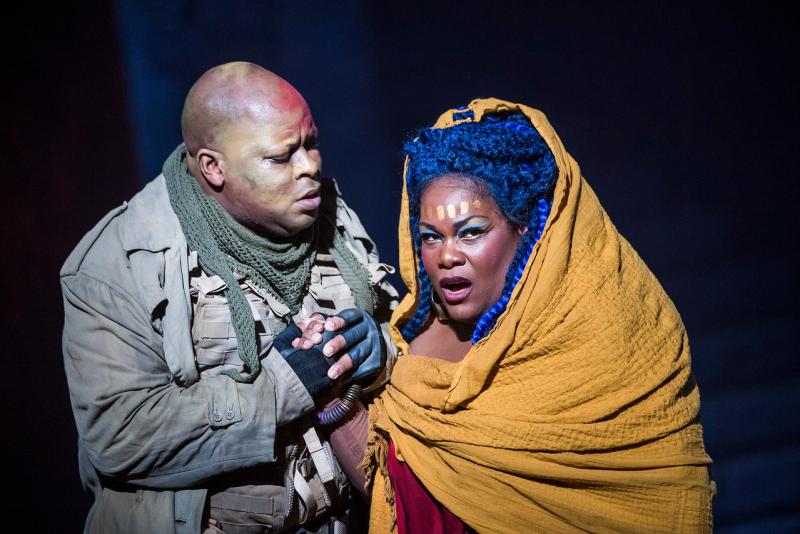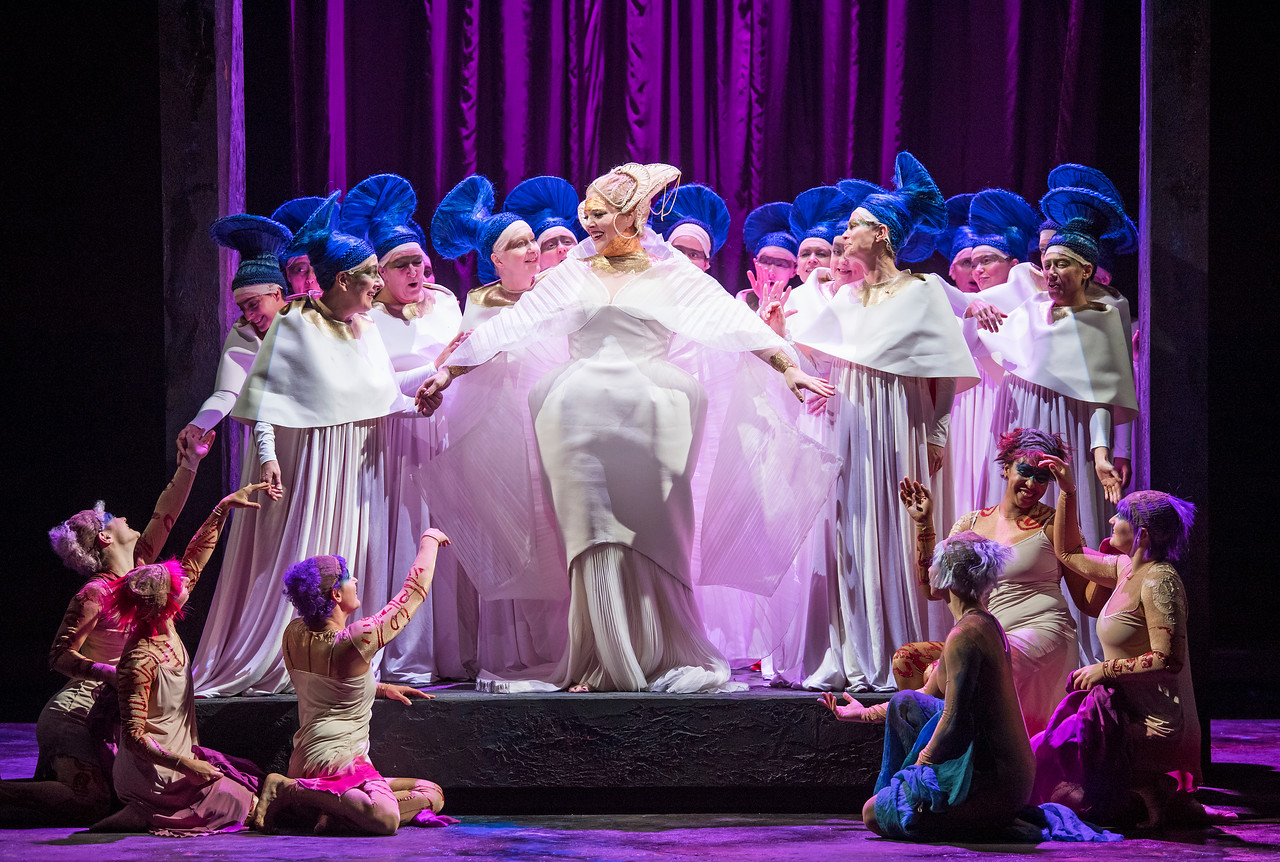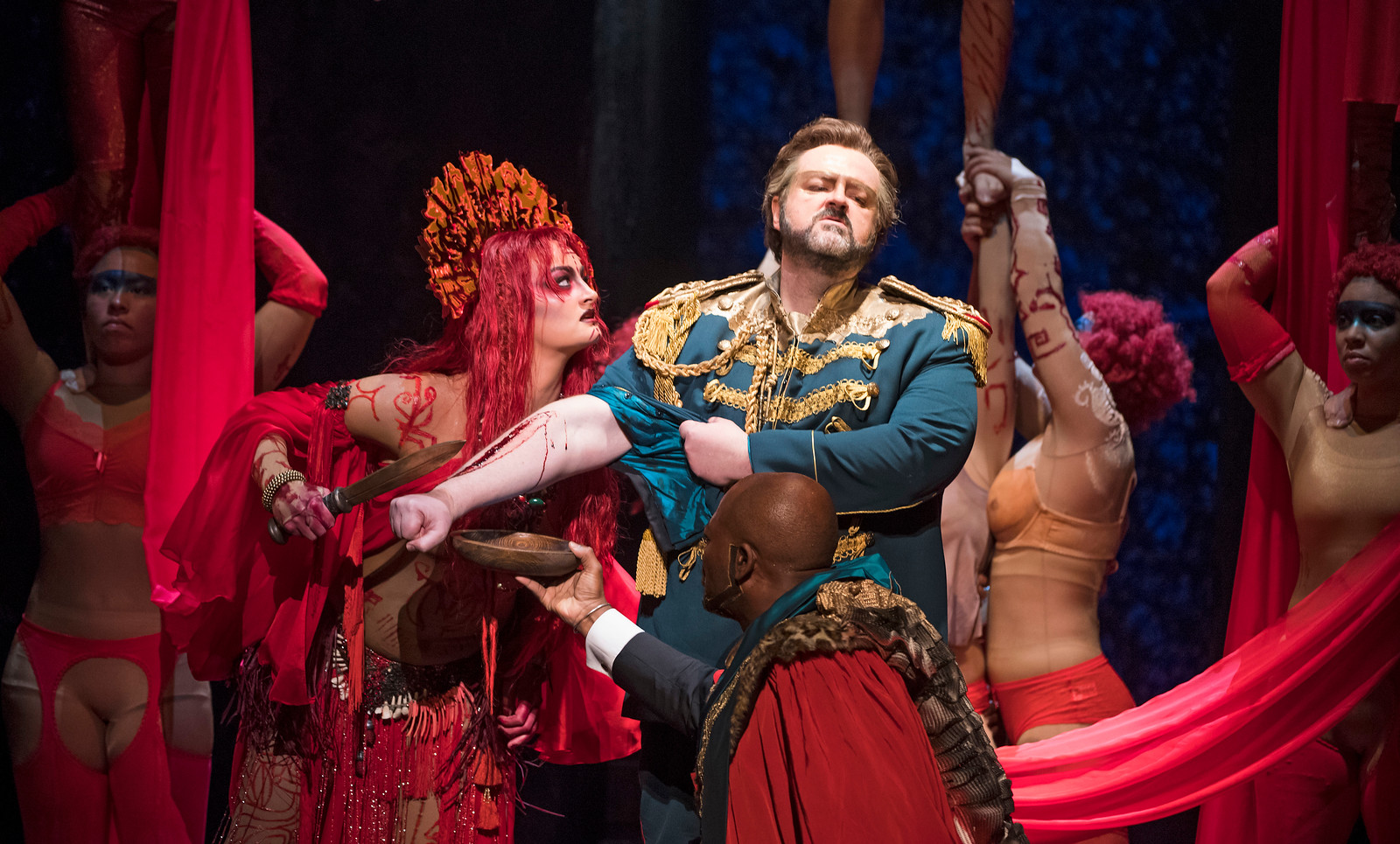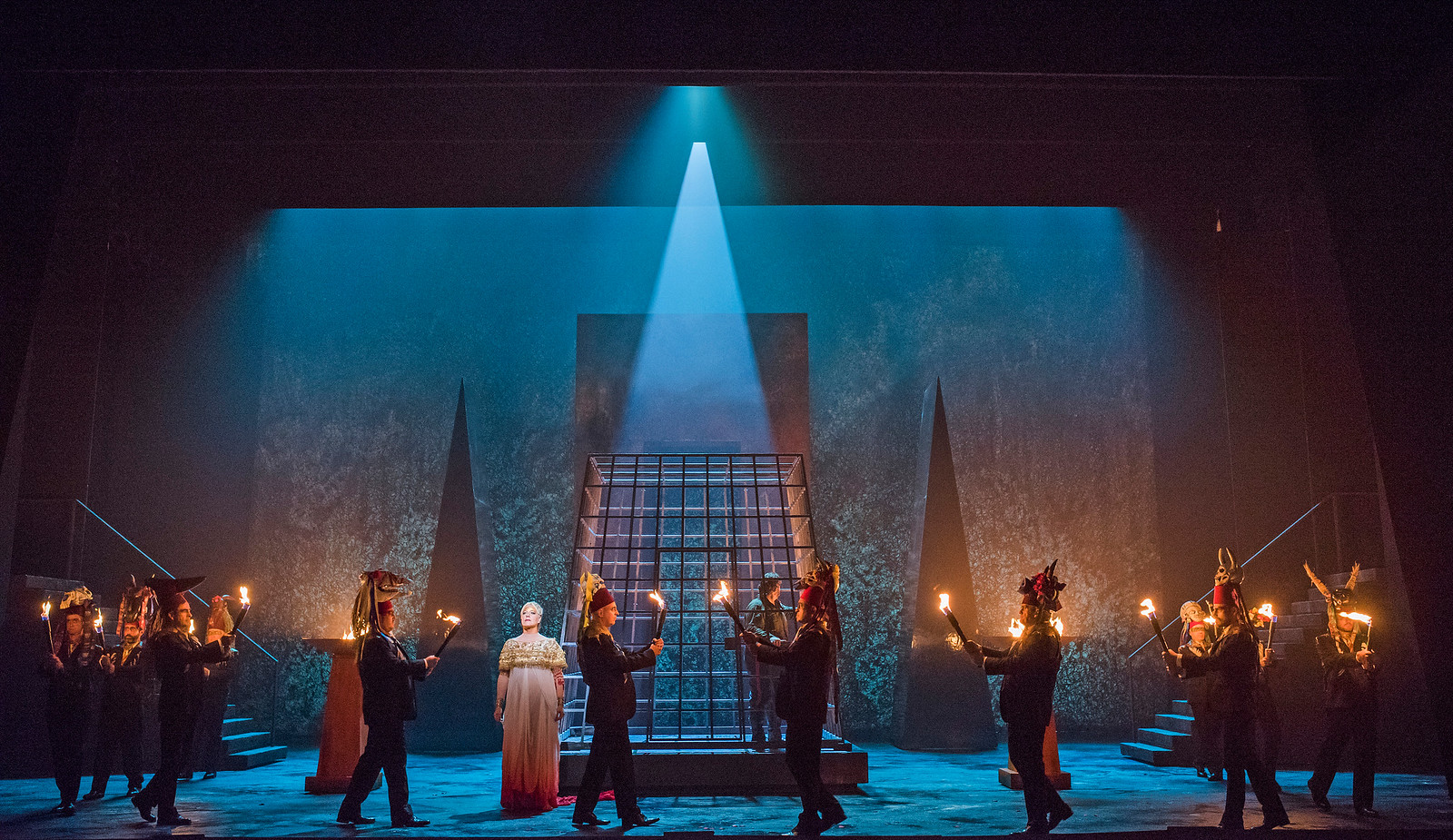Aida, English National Opera review - heroine almost saves a dismal day | reviews, news & interviews
Aida, English National Opera review - heroine almost saves a dismal day
Aida, English National Opera review - heroine almost saves a dismal day
Phelim McDermott's static and shallow production hosts one glorious performance

If the best is the enemy of the good, then the excellent is also the enemy of the "meh". And if you can stomach Verdi's Aida, go and see English National Opera’s new production for its central performance by Latonia Moore.
Aida and Princess Amneris both love the Egyptian military hero Radames. He loves Aida, so the jealous Amneris decides to destroy them both. Aida’s father, King Amonasro of Ethiopa, captured and hiding his identity, turns her into a honey-trap to get military secrets from Radames, who is tried for treason and ultimately buried alive; Aida hides in his tomb to die with him. The strong simplicity of plot that so endears this opera to its public is also problematic, because if interpretations lack subtlety, in part it’s the fault of Verdi and his librettist Antonio Ghislanzoni: the characters are scarcely more rounded than a pantomime’s. It is down to director and cast to give them some convincing depth. Still, there’s spectacle, and everyone loves spectacle, except they might love this one a little bit less. It has its moments. The large, static choral scenes match the monolithic shapes of Tom Pye’s sets to some degree, there are some pretty colours, with rippling silk effects created by Basil Twist; and the beautiful, slanted, varied lighting by Bruno Poet is the subtlest thing on stage. But too often the static direction becomes almost ossified. Kevin Pollard’s timeless costumes don’t always help. Elaborate hieroglyph-inspired head-pieces, exotic venerations of Isis (ancient goddess, not so-called Islamic State), and Radames’s rather 19th century military uniform sit awkwardly with otherwise updated imagery and poor old Amneris is trussed into a white contraption that might have looked happier in 1970s science fiction (Michelle DeYoung's Amneris pictured above with attendants).
Still, there’s spectacle, and everyone loves spectacle, except they might love this one a little bit less. It has its moments. The large, static choral scenes match the monolithic shapes of Tom Pye’s sets to some degree, there are some pretty colours, with rippling silk effects created by Basil Twist; and the beautiful, slanted, varied lighting by Bruno Poet is the subtlest thing on stage. But too often the static direction becomes almost ossified. Kevin Pollard’s timeless costumes don’t always help. Elaborate hieroglyph-inspired head-pieces, exotic venerations of Isis (ancient goddess, not so-called Islamic State), and Radames’s rather 19th century military uniform sit awkwardly with otherwise updated imagery and poor old Amneris is trussed into a white contraption that might have looked happier in 1970s science fiction (Michelle DeYoung's Amneris pictured above with attendants).
No elephants. Instead, the triumphal march accompanies the return of some coffins. Arguably, of course, it is a grotesque moment: Aida’s people have been defeated, her father has been taken prisoner, and her enslaver is stealing her lover. So it’s valid – but grim nonetheless. Radames enters at the height of it to flurries of red bits of paper (plus audible pops as they’re released). Redemption could be found in the team of fabulous on-stage trumpeters. None of the visuals would matter if the characters were fully explored and their interactions were vivid, but few were the moments when that happened; and instead of addressing one another, they mostly had to stand metres apart and bark forwards. Some crucial scenes barely featured eye contact.
None of the visuals would matter if the characters were fully explored and their interactions were vivid, but few were the moments when that happened; and instead of addressing one another, they mostly had to stand metres apart and bark forwards. Some crucial scenes barely featured eye contact.
Michelle DeYoung’s Amneris never lost her regal stance or full tone, but so much more could be made of her inner conflict, terrible jealousy and, above all, the sonic colours of this huge role. Tenor Gwyn Hughes Jones (pictured above) carried the role of Radames well and was strong vocally, with plenty of ping in the high notes, yet even he could not quite transcend the cardboard cut-out direction. Amonasro was the South African bass-baritone Musa Ngqungwana, making his UK debut, with excellent, warm tone, but perhaps without quite the requisite power of presence. The Egyptian King, Matthew Best, again sang creditably, but with scant personality. Eleanor Dennis, an ENO Harewood Artist, was notable as a Priestess with seductively beautiful tone. Despite good individual components, the whole failed to ignite; the final scene, with Aida and Radames united in the tomb and the regretful Amneris above them, nevertheless moved onto another level, taking Verdi on his own terms at last. The chorus mostly stood and delivered, which they did extremely well, with the hushed moments especially fine. There was strong playing from the orchestra under the baton of Keri-Lyn Wilson, who took often brisk tempi and provided solid support to her soloists’ voices, mainly without drowning them in orchestral splendour and cavernous Coliseum space.
The chorus mostly stood and delivered, which they did extremely well, with the hushed moments especially fine. There was strong playing from the orchestra under the baton of Keri-Lyn Wilson, who took often brisk tempi and provided solid support to her soloists’ voices, mainly without drowning them in orchestral splendour and cavernous Coliseum space.
There is one elephant in the theatre: it’s Verdi in English. Or Verdi in this English. Some composers translate better than others, and Verdi is one of the thorniest of all. Even so, this version is so clunky that it not only disrupts occasional rhythms but also distracts from its purpose, which presumably is to make the drama more immediate. Aida shouldn’t leave you laughing – but when rhyming couplets match “Isis” with “[in]side us”, and “shelter” with “Delta”, splashed loud and clear over the surtitles, you can’t help thinking that ENO’s opera-in-English mandate is past its sell-by date.
Add comment
The future of Arts Journalism
You can stop theartsdesk.com closing!
We urgently need financing to survive. Our fundraising drive has thus far raised £33,000 but we need to reach £100,000 or we will be forced to close. Please contribute here: https://gofund.me/c3f6033d
And if you can forward this information to anyone who might assist, we’d be grateful.

Subscribe to theartsdesk.com
Thank you for continuing to read our work on theartsdesk.com. For unlimited access to every article in its entirety, including our archive of more than 15,000 pieces, we're asking for £5 per month or £40 per year. We feel it's a very good deal, and hope you do too.
To take a subscription now simply click here.
And if you're looking for that extra gift for a friend or family member, why not treat them to a theartsdesk.com gift subscription?
more Opera
 Help to give theartsdesk a future!
Support our GoFundMe appeal
Help to give theartsdesk a future!
Support our GoFundMe appeal
 Owen Wingrave, RNCM, Manchester review - battle of a pacifist
Orpha Phelan brings on the big guns for Britten’s charge against war
Owen Wingrave, RNCM, Manchester review - battle of a pacifist
Orpha Phelan brings on the big guns for Britten’s charge against war
 Tales of Apollo and Hercules, London Handel Festival review - compelling elements, but a failed experiment
Conceptually the two cantatas just don't work together
Tales of Apollo and Hercules, London Handel Festival review - compelling elements, but a failed experiment
Conceptually the two cantatas just don't work together
 La finta giardiniera, The Mozartists, Cadogan Hall review - blooms in the wild garden
Mozart's rambling early opera can still smell sweet
La finta giardiniera, The Mozartists, Cadogan Hall review - blooms in the wild garden
Mozart's rambling early opera can still smell sweet
 Der fliegende Holländer, Irish National Opera review - sailing to nowhere
Plenty of strong singing and playing, but the staging is static or inept
Der fliegende Holländer, Irish National Opera review - sailing to nowhere
Plenty of strong singing and playing, but the staging is static or inept
 Die Zauberflöte, Royal Academy of Music review - first-rate youth makes for a moving experience
The production takes time to match Mozart's depths, but gets there halfway through
Die Zauberflöte, Royal Academy of Music review - first-rate youth makes for a moving experience
The production takes time to match Mozart's depths, but gets there halfway through
 Mansfield Park, Guildhall School review - fun when frothy, chugging in romantic entanglements
Jonathan Dove’s strip-cartoon Jane Austen works well as a showcase for students
Mansfield Park, Guildhall School review - fun when frothy, chugging in romantic entanglements
Jonathan Dove’s strip-cartoon Jane Austen works well as a showcase for students
 Uprising, Glyndebourne review - didactic community opera superbly performed
Jonathan Dove and April De Angelis go for the obvious, but this is still a rewarding project
Uprising, Glyndebourne review - didactic community opera superbly performed
Jonathan Dove and April De Angelis go for the obvious, but this is still a rewarding project
 Fledermaus, Irish National Opera review - sex, please, we're Viennese/American/Russian/Irish
Vivacious company makes the party buzz, does what it can around it
Fledermaus, Irish National Opera review - sex, please, we're Viennese/American/Russian/Irish
Vivacious company makes the party buzz, does what it can around it
 The Capulets and the Montagues, English Touring Opera review - the wise guys are singing like canaries
There's a bel canto feast when Bellini joins the Mob
The Capulets and the Montagues, English Touring Opera review - the wise guys are singing like canaries
There's a bel canto feast when Bellini joins the Mob
 Mary, Queen of Scots, English National Opera review - heroic effort for an overcooked history lesson
Heidi Stober delivers as beleaguered regent, but Thea Musgrave's opera is limiting
Mary, Queen of Scots, English National Opera review - heroic effort for an overcooked history lesson
Heidi Stober delivers as beleaguered regent, but Thea Musgrave's opera is limiting
 Festen, Royal Opera review - firing on every front
No slack in Mark-Anthony Turnage's operatic treatment of the visceral first Dogme film
Festen, Royal Opera review - firing on every front
No slack in Mark-Anthony Turnage's operatic treatment of the visceral first Dogme film

Comments
I attended the last